Demographics of Italy
| Demographics of Italy | |
|---|---|
 Population pyramid of Italy as of 2022 | |
| Population | |
| Growth rate | |
| Birth rate | |
| Death rate | |
| Life expectancy | |
| • male | |
| • female | |
| Fertility rate | |
| Infant mortality rate | |
| Net migration rate | |
| Age structure | |
| 0–14 years | |
| 15–64 years | |
| 65 and over | |
| Nationality | |
| Nationality | noun: Italian(s) adjective: Italian |
| Major ethnic | Italians |
| Minor ethnic | |
| Language | |
| Official | Italian |
| Spoken | Languages of Italy |
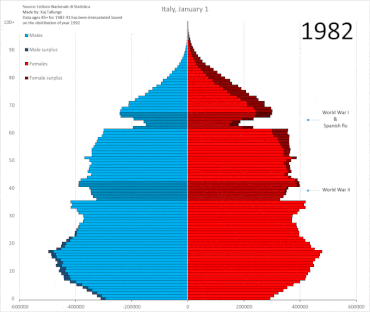
Demographic features of the population of Italy include population density, ethnicity, education level, health of the populace, economic status, religious affiliations and other aspects.
At the beginning of 2024, Italy had an estimated population of 58.9 million. Its population density, at 195.7 inhabitants per square kilometre (507/sq mi), is higher than that of most Western European countries. However, the distribution of the population is very uneven: the most densely populated areas are the Po Valley (with about a third of the country's population) in northern Italy and the metropolitan areas of Rome and Naples in central and southern Italy, while large rural areas are very sparsely populated, like the plateaus of Basilicata, the Alps and Apennines highlands, and the island of Sardinia.
The population of the country almost doubled during the 20th century, but the pattern of growth was extremely uneven due to large-scale internal migration from the rural South to the industrial cities of the North, due to the Italian economic miracle of the 1950s and 1960s. In addition, after centuries of net emigration, since the 1980s Italy has experienced large-scale immigration for the first time in modern history. Italian government data, in its annual report for 2019, estimated the number of foreign nationals residing within Italy, including immigrants, at about 5.234 million.[3] Due to such large-scale immigration to the country, particularly from the early 2000s to 2014, the population peaked at 60.79 million. Since then, decreasing migration, a continuously falling birth rate, and continuous aging have led to a sharp decrease in the Italian population.
High fertility and birth rates persisted until the 1970s, after which they started to dramatically decline, leading to rapid population aging. At the end of the 2000s decade, one in five Italians was over 65 years old.[4] Italy experienced a short-term growth in birth rates.[5] The total fertility rate temporarily rose from an all-time low of 1.18 children per woman in 1995 to 1.46 in 2010.[6] Since then, fertility rates have resumed their decline, to reach a low of 1.24 in 2022.[7]
Since the revision of the Lateran Treaty in 1984, Italy has no official religion, although it continues to recognize the role the Catholic Church plays in Italian society. In 2017, 78% of the population identified as Catholic, 15% as non-believers or atheists, 2% as other Christians and 6% adhered to other religions.[8]
Historical overview
1861 to early 20th century
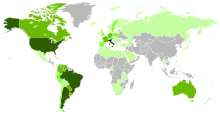
From its unification in 1861 to the Italian economic miracle of the 1950s and 1960s, Italy has been a country of mass emigration. Between 1898 and 1914, the peak years of Italian diaspora, approximately 750,000 Italians emigrated each year.[9] As a consequence, large numbers of people with full or significant Italian ancestry are found in Brazil (32 million Italian Brazilians),[10][11] Argentina (25 million Italian Argentines),[12] United States (18 million Italian Americans),[13] France (5 million Italian French),[14] Venezuela (5 million Italian Venezuelans),[15] Paraguay (2.5 million Italian Paraguayans),[16][17][18] Colombia (2 million Italian Colombians),[19] Uruguay (1.5 million Italian Uruguayans),[20] Peru (1.5 million Italian Peruvians),[21] Canada (1.5 million Italian Canadians),[22] Germany (1.2 million Italian Germans)[23] and Australia (1 million Italian Australians).[24] In addition, Italian communities once thrived in the former African colonies of Eritrea (nearly 100,000 at the beginning of World War II),[25] Somalia and Libya (150,000 Italians settled in Libya, constituting about 18% of the total Libyan population).[26]
After World War II
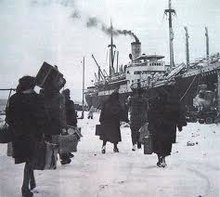
After Tito's annexation of Istria, Kvarner, most of the Julian March as well as the Dalmatian city of Zara following the Treaty of Peace with Italy, 1947, up to 350,000 local ethnic Italians (Istrian Italians and Dalmatian Italians) left communist Yugoslavia (Istrian–Dalmatian exodus).[27][28] Furthermore, all of Libya's Italians were expelled after Muammar Gaddafi's takeover in 1970.[29]
As a result of the profound economic and social changes brought by rapid postwar economic growth, including low birth rates, an aging population and thus a shrinking workforce, by the 1970s emigration had all but stopped and Italy started to have a positive net migration rate.[30] The nation's immigrant population reached 5 million by 2015, making up some 8% of the total population.[31] However, the long-lasting effects of the Eurozone crisis double-dip recession strongly slowed down immigration rates in Italy in the 2010s.[32]
In calendar years 2020 and 2021, as a direct effect of COVID-19 pandemic and Deltacron hybrid variant, Italy registered at least 178,000 excess deaths, a reduction of about 1.4 years in the average life expectancy, a noticeable decrease in birth rates and a marked decrease in immigration rates. Thus there was a record natural population decline of 342,042 units in that[clarification needed] year, the largest ever recorded since 1918 (at the time of World War I and the Spanish flu pandemic).[33] In 2022, Italy's birth rate declined to its lowest level on record since 1861, with fewer than 400,000 births recorded that year.[34][35][36][37][38][39]
Population
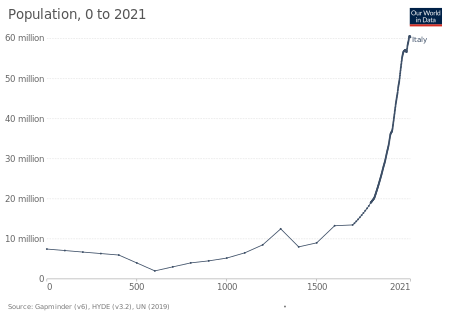
| Year | Pop. | ±% p.a. |
|---|---|---|
| 1861 | 21,777,334 | — |
| 1871 | 26,801,154 | +2.10% |
| 1881 | 28,459,628 | +0.60% |
| 1901 | 32,475,253 | +0.66% |
| 1911 | 34,671,377 | +0.66% |
| 1921 | 37,973,977 | +0.91% |
| 1931 | 41,176,671 | +0.81% |
| 1936 | 42,993,602 | +0.87% |
| 1951 | 47,515,537 | +0.67% |
| 1961 | 50,623,569 | +0.64% |
| 1971 | 54,136,547 | +0.67% |
| 1981 | 56,556,911 | +0.44% |
| 1991 | 56,778,031 | +0.04% |
| 2001 | 56,995,744 | +0.04% |
| 2011 | 59,433,744 | +0.42% |
| 2021 | 59,257,566 | −0.03% |
| 2024 (est.) | 58,968,501 | −0.16% |
| Source: ISTAT[40][41][33] | ||
Life expectancy
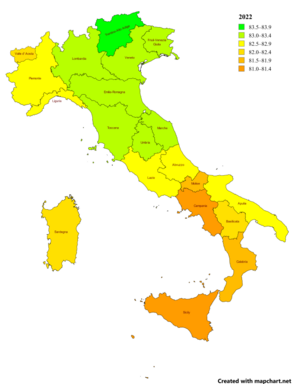
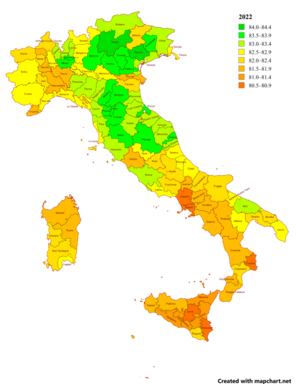
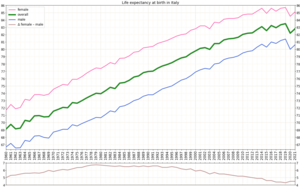
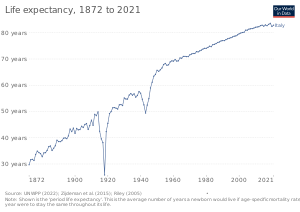
Sources: Our World In Data and the United Nations. 1871–1950
| Years | 1871 | 1872 | 1873 | 1874 | 1875 | 1876 | 1877 | 1878 | 1879 | 1880[43] |
|---|---|---|---|---|---|---|---|---|---|---|
| Life expectancy | 29.8 | 29.7 | 31.6 | 31.8 | 31.3 | 33.6 | 34.9 | 34.3 | 34.0 | 32.8 |
| Years | 1881 | 1882 | 1883 | 1884 | 1885 | 1886 | 1887 | 1888 | 1889 | 1890[43] |
| Life expectancy | 34.2 | 34.3 | 35.2 | 36.6 | 36.9 | 35.1 | 36.0 | 37.0 | 39.1 | 38.5 |
| Years | 1891 | 1892 | 1893 | 1894 | 1895 | 1896 | 1897 | 1898 | 1899 | 1900[43] |
| Life expectancy | 38.5 | 38.9 | 39.8 | 40.0 | 39.6 | 40.7 | 43.3 | 42.3 | 43.7 | 41.7 |
| Years | 1901 | 1902 | 1903 | 1904 | 1905 | 1906 | 1907 | 1908 | 1909 | 1910[43] |
| Life expectancy | 43.5 | 43.0 | 43.1 | 44.4 | 43.9 | 45.1 | 45.4 | 43.1 | 44.6 | 46.7 |
| Years | 1911 | 1912 | 1913 | 1914 | 1915 | 1916 | 1917 | 1918 | 1919 | 1920[43] |
| Life expectancy | 44.7 | 48.9 | 48.4 | 49.9 | 42.5 | 39.6 | 38.1 | 25.8 | 42.3 | 45.5 |
| Years | 1921 | 1922 | 1923 | 1924 | 1925 | 1926 | 1927 | 1928 | 1929 | 1930[43] |
| Life expectancy | 49.2 | 50.0 | 51.4 | 51.5 | 51.3 | 50.9 | 52.5 | 52.6 | 52.3 | 55.2 |
| Years | 1931 | 1932 | 1933 | 1934 | 1935 | 1936 | 1937 | 1938 | 1939 | 1940[43] |
| Life expectancy | 54.8 | 54.7 | 56.3 | 56.8 | 56.2 | 56.7 | 55.5 | 56.1 | 57.6 | 57.0 |
| Years | 1941 | 1942 | 1943 | 1944 | 1945 | 1946 | 1947 | 1948 | 1949 | 1950[43] |
| Life expectancy | 54.7 | 52.5 | 49.4 | 52.4 | 54.9 | 59.0 | 61.2 | 63.4 | 64.1 | 65.8 |
1950–2020
| Period | Life expectancy in Years |
Period | Life expectancy in Years |
|---|---|---|---|
| 1950–1955 | 66.5 | 1985–1990 | 76.4 |
| 1955–1960 | 68.4 | 1990–1995 | 77.5 |
| 1960–1965 | 69.7 | 1995–2000 | 78.8 |
| 1965–1970 | 70.9 | 2000–2005 | 80.3 |
| 1970–1975 | 72.2 | 2005–2010 | 81.5 |
| 1975–1980 | 73.6 | 2010–2015 | 82.4 |
| 1980–1985 | 74.9 | 2015–2020 | 83.3 |
Source: UN World Population Prospects[44]
Fertility
By 2021, the number of births had fallen to 400,249, a decrease of 25% compared to 2011. If the trend is not reversed, it may adversely affect GDP growth and social security benefits.[45] The reasons that Italians give for not having children are economic costs, fear of losing their job and lack of services for families, but it is claimed that these problems have ceased to be the main motivation for childlessness.[dubious – discuss][45] Other countries such as Sweden and France with superior childcare service and better job conditions also have birth rates below the population replacement level, which is approximately 2.1.
Historical fertility rates
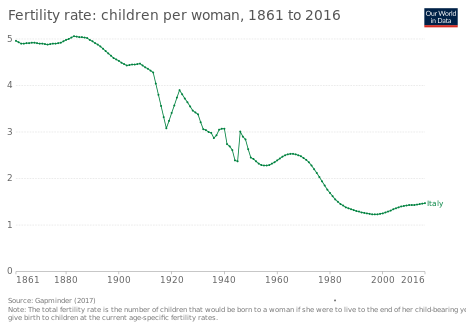
The total fertility rate is the number of children born per woman. This table is based on fairly good data for the entire period. Sources: Our World in Data and Gapminder Foundation.[46]

| Years | 1850 | 1851 | 1852 | 1853 | 1854 | 1855 | 1856 | 1857 | 1858 | 1859 | 1860 |
|---|---|---|---|---|---|---|---|---|---|---|---|
| Rate | 5.47 | 5.42 | 5.38 | 5.33 | 5.29 | 5.24 | 5.19 | 5.15 | 5.10 | 5.06 | 5.01 |
| Years | 1861 | 1862 | 1863 | 1864 | 1865 | 1866 | 1867 | 1868 | 1869 | 1870 | |
| Rate | 4.96 | 4.93 | 4.90 | 4.90 | 4.91 | 4.91 | 4.92 | 4.92 | 4.91 | 4.90 | |
| Years | 1871 | 1872 | 1873 | 1874 | 1875 | 1876 | 1877 | 1878 | 1879 | 1880 | |
| Rate | 4.90 | 4.89 | 4.88 | 4.89 | 4.9 | 4.9 | 4.91 | 4.92 | 4.95 | 4.98 | |
| Years | 1881 | 1882 | 1883 | 1884 | 1885 | 1886 | 1887 | 1888 | 1889 | 1890 | |
| Rate | 5.00 | 5.03 | 5.06 | 5.05 | 5.04 | 5.04 | 5.03 | 5.02 | 4.98 | 4.95 | |
| Years | 1891 | 1892 | 1893 | 1894 | 1895 | 1896 | 1897 | 1898 | 1899 | ||
| Rate | 4.91 | 4.88 | 4.84 | 4.79 | 4.74 | 4.69 | 4.64 | 4.59 | 4.56 |
In 2021 this was 1.47 children born/woman.
Mother's mean age at first birth; 31.1 years (2017 est.)
Internal migration

Internal migration in Italy is a human migration within the Italian geographical region that occurred for similar reasons to emigration, primarily socioeconomic.[47] Its largest wave consisted of 4 million people moving from Southern Italy to Northern Italy (and mostly to Northern or Central Italian industrial cities like Rome or Milan, etc.), between the 1950s and 1970s.[48]
The oldest migration goes back to the 11th century when soldiers and settlers from Northern Italy (at the time collectively called "Lombardy"[49]), settled the central and eastern part of Sicily during the Norman conquest of southern Italy. After the marriage between the Norman king Roger I of Sicily with Adelaide del Vasto, member of Aleramici family, many Lombard colonisers left their homeland, in the Aleramici's possessions in Piedmont and Liguria, to settle on the island of Sicily.[50][51] The migration of people from Northern Italy to Sicily continued until the end of the 13th century.[52]
Age structure
- 0-14 years: 0–14 years: 13.45% (male 4,292,431/female 4,097,732)
- 15-24 years: 9.61% (male 3,005,402/female 2,989,764)
- 25-54 years: 40.86% (male 12,577,764/female 12,921,614)
- 55-64 years: 14% (male 4,243,735/female 4,493,581)
- 65 years and over: 22.08% (male 5,949,560/female 7,831,076) (2020 est.)
Median age
- total: 46.5 years. Country comparison to the world: 5th
- male: 45.4 years
- female: 47.5 years (2020 est.)
Cities
70.4% of Italian population is classified as urban,[53] a relatively low figure among developed countries. Italy's administrative boundaries have seen significant devolution in recent decades; the metropolitan area was created as a new administrative unit, and major cities and metro areas now have a provincial status.
According to OECD,[54] the largest conurbations are:
Urbanization
- urban population: 71% of total population (2020)
- rate of urbanization: 0.29% annual rate of change (2015–20 est.)
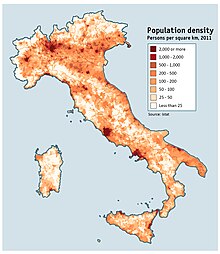
| Metropolitan city | Region | Area (km2) |
Population (1 January 2019) |
Functional Urban Areas (FUA) Population (2016) |
|---|---|---|---|---|
| Rome | Lazio | 5,352 | 4,342,212 | 4,414,288 |
| Milan | Lombardy | 1,575 | 3,250,315 | 5,111,481 |
| Naples | Campania | 1,171 | 3,084,890 | 3,418,061 |
| Turin | Piedmont | 6,829 | 2,259,523 | 1,769,475 |
| Palermo | Sicily | 5,009 | 1,252,588 | 1,033,226 |
| Bari | Apulia | 3,821 | 1,251,994 | 749,723 |
| Catania | Sicily | 3,574 | 1,107,702 | 658,805 |
| Florence | Tuscany | 3,514 | 1,011,349 | 807,896 |
| Bologna | Emilia-Romagna | 3,702 | 1,014,619 | 775,247 |
| Genoa | Liguria | 1,839 | 841,180 | 713,243 |
| Venice | Veneto | 2,462 | 853,338 | 561,697 |
| Messina | Sicily | 3,266 | 626,876 | 273,680 |
| Reggio Calabria | Calabria | 3,183 | 548,009 | 221,139 |
| Cagliari | Sardinia | 1,248 | 431,038 | 488,954 |
Vital statistics
| Average population (January 1) | Live births | Deaths[63] | Natural change | Crude birth rate (per 1,000) | Crude death rate (per 1,000) | Natural change (per 1,000) | Crude migration change (per 1,000) | Total fertility rates[fn 1][46][64] | |
|---|---|---|---|---|---|---|---|---|---|
| 1900 | 32,377,000 | 1,067,376 | 768,917 | 298,459 | 33.0 | 23.7 | 9.2 | -3.9 | 4.53 |
| 1901 | 32,550,000 | 1,057,763 | 715,036 | 342,727 | 32.5 | 22.0 | 10.5 | -3.2 | 4.49 |
| 1902 | 32,787,000 | 1,093,074 | 727,181 | 365,893 | 33.3 | 22.2 | 11.2 | -4.6 | 4.46 |
| 1903 | 33,004,000 | 1,042,090 | 736,311 | 305,779 | 31.6 | 22.3 | 9.3 | -2.2 | 4.43 |
| 1904 | 33,237,000 | 1,085,431 | 698,604 | 386,827 | 32.7 | 21.0 | 11.6 | -4.0 | 4.44 |
| 1905 | 33,489,000 | 1,084,518 | 730,340 | 354,178 | 32.4 | 21.8 | 10.6 | -3.8 | 4.45 |
| 1906 | 33,718,000 | 1,070,978 | 696,875 | 374,103 | 31.8 | 20.7 | 11.1 | -4.2 | 4.45 |
| 1907 | 33,952,000 | 1,062,333 | 700,333 | 362,000 | 31.3 | 20.6 | 10.7 | -3.5 | 4.46 |
| 1908 | 34,198,000 | 1,138,813 | 770,054 | 368,759 | 33.3 | 22.5 | 10.8 | -3.3 | 4.47 |
| 1909 | 34,455,000 | 1,115,831 | 738,460 | 377,371 | 32.4 | 21.4 | 11.0 | -2.4 | 4.43 |
| 1910 | 34,751,000 | 1,144,410 | 682,459 | 461,951 | 32.9 | 19.6 | 13.3 | -5.2 | 4.39 |
| 1911 | 35,033,000 | 1,093,545 | 742,811 | 350,734 | 31.2 | 21.2 | 10.0 | -3.9 | 4.36 |
| 1912 | 35,246,000 | 1,133,985 | 635,788 | 498,197 | 32.2 | 18.0 | 14.1 | -11.1 | 4.32 |
| 1913 | 35,351,000 | 1,122,482 | 663,966 | 458,516 | 31.8 | 18.8 | 13.0 | -3.1 | 4.28 |
| 1914 | 35,701,000 | 1,114,091 | 643,355 | 470,736 | 31.2 | 18.0 | 13.2 | 2.8 | 4.04 |
| 1915 | 36,271,000 | 1,109,183 | 809,703 | 299,480 | 30.6 | 22.3 | 8.3 | -2.5 | 3.80 |
| 1916 | 36,481,000 | 881,626 | 854,703 | 26,923 | 24.2 | 23.4 | 0.7 | -4.5 | 3.56 |
| 1917 | 36,343,000 | 691,207 | 948,710 | -257,503 | 19.6 | 26.1 | -7.1 | -4.5 | 3.32 |
| 1918 | 35,922,000 | 640,263 | 1,268,290 | -628,027 | 18.2 | 35.3 | -17.5 | 11.8 | 3.08 |
| 1919 | 35,717,000 | 770,620 | 676,329 | 94,291 | 21.6 | 18.9 | 2.6 | 4.2 | 3.24 |
| 1920 | 35,960,000 | 1,158,041 | 681,749 | 476,292 | 32.2 | 19.0 | 13.2 | 39.9 | 3.41 |
| 1921 | 37,869,000 | 1,118,344 | 670,234 | 448,110 | 30.7 | 17.7 | 13.0 | -4.4 | 3.57 |
| 1922 | 38,196,000 | 1,127,444 | 690,054 | 437,390 | 30.8 | 18.1 | 12.7 | -2.9 | 3.74 |
| 1923 | 38,571,000 | 1,107,505 | 654,827 | 452,678 | 29.9 | 17.0 | 11.7 | -2.5 | 3.90 |
| 1924 | 38,927,000 | 1,124,470 | 663,077 | 461,393 | 28.9 | 17.0 | 11.9 | -3.2 | 3.81 |
| 1925 | 39,265,000 | 1,109,761 | 669,695 | 440,066 | 28.2 | 17.1 | 11.2 | -2.9 | 3.72 |
| 1926 | 39,590,000 | 1,094,587 | 680,274 | 414,313 | 27.7 | 17.2 | 10.5 | -2.0 | 3.64 |
| 1927 | 39,926,000 | 1,093,772 | 639,843 | 453,929 | 27.4 | 16.0 | 11.4 | -2.5 | 3.55 |
| 1928 | 40,281,000 | 1,072,316 | 645,654 | 426,662 | 26.6 | 16.0 | 10.6 | -2.5 | 3.46 |
| 1929 | 40,607,000 | 1,037,700 | 667,223 | 370,477 | 25.6 | 16.4 | 9.1 | -0.5 | 3.42 |
| 1930 | 40,956,000 | 1,092,678 | 576,751 | 515,927 | 26.7 | 14.1 | 12.6 | -3.2 | 3.38 |
| 1931 | 41,339,000 | 1,026,197 | 609,405 | 416,792 | 24.8 | 14.7 | 10.1 | -4.2 | 3.21 |
| 1932 | 41,584,000 | 990,995 | 610,646 | 380,349 | 23.8 | 14.7 | 9.1 | -0.8 | 3.06 |
| 1933 | 41,928,000 | 995,979 | 574,113 | 421,866 | 23.8 | 13.7 | 10.1 | -1.8 | 3.04 |
| 1934 | 42,277,000 | 992,966 | 563,339 | 429,627 | 23.5 | 13.3 | 10.2 | -1.8 | 3.00 |
| 1935 | 42,631,000 | 996,708 | 594,722 | 401,986 | 23.4 | 14.0 | 9.4 | -1.6 | 2.98 |
| 1936 | 42,965,000 | 962,686 | 593,380 | 369,306 | 22.4 | 13.8 | 8.6 | -1.5 | 2.87 |
| 1937 | 43,269,000 | 991,867 | 618,290 | 373,577 | 22.9 | 14.3 | 8.6 | -1.0 | 2.93 |
| 1938 | 43,596,000 | 1,037,180 | 614,988 | 422,192 | 23.8 | 14.1 | 9.7 | 0 | 3.05 |
| 1939 | 44,018,000 | 1,040,213 | 591,483 | 448,730 | 23.6 | 13.4 | 10.2 | 0 | 3.07 |
| 1940 | 44,467,000 | 1,046,479 | 606,907 | 439,572 | 23.5 | 13.6 | 9.9 | -1.7 | 3.07 |
| 1941 | 44,830,000 | 937,546 | 621,735 | 315,811 | 20.9 | 13.9 | 7.0 | -1.0 | 2.74 |
| 1942 | 45,098,000 | 926,063 | 643,607 | 282,456 | 20.5 | 14.3 | 6.3 | -16.4 | 2.69 |
| 1943 | 44,641,000 | 882,105 | 679,708 | 202,397 | 19.8 | 15.2 | 4.5 | -1.1 | 2.61 |
| 1944 | 44,794,000 | 814,746 | 685,171 | 129,575 | 18.3 | 15.3 | 2.9 | 0.5 | 2.39 |
| 1945 | 44,946,000 | 815,678 | 615,092 | 200,586 | 18.2 | 13.7 | 4.5 | 2.3 | 2.37 |
| 1946 | 45,253,000 | 1,036,098 | 547,952 | 488,146 | 23.0 | 12.1 | 10.8 | -2.2 | 3.01 |
| 1947 | 45,641,000 | 1,011,490 | 524,019 | 487,471 | 22.2 | 11.5 | 10.8 | 5.4 | 2.89 |
| 1948 | 46,381,000 | 1,005,851 | 490,450 | 515,401 | 21.8 | 10.6 | 11.2 | -3.6 | 2.83 |
| 1949 | 46,733,000 | 937,146 | 485,277 | 451,869 | 20.1 | 10.4 | 9.7 | -1.8 | 2.62 |
| 1950 | 47,104,000 | 908,622 | 455,169 | 453,453 | 19.3 | 9.7 | 9.6 | -3.0 | 2.50 |
| 1951 | 47,417,000 | 860,998 | 485,208 | 375,790 | 18.2 | 10.2 | 7.9 | -2.6 | 2.35 |
| 1952 | 47,666,000 [65] | 863,661 | 488,470 | 375,191 | 17.7 | 10.0 | 7.7 | -1.6 | 2.34 |
| 1953 | 47,957,000 | 860,345 | 484,527 | 375,818 | 17.5 | 9.9 | 7.6 | -0.5 | 2.31 |
| 1954 | 48,299,000 | 881,845 | 445,902 | 435,943 | 18.0 | 9.1 | 8.9 | -2.0 | 2.35 |
| 1955 | 48,633,000 | 879,130 | 449,058 | 430,072 | 17.9 | 9.2 | 8.7 | -2.8 | 2.33 |
| 1956 | 48,920,000 | 884,043 | 499,504 | 384,539 | 17.9 | 10.2 | 7.7 | -2.4 | 2.34 |
| 1957 | 49,181,000 | 885,812 | 483,558 | 402.254 | 17.9 | 9.8 | 8.0 | -2.0 | 2.33 |
| 1958 | 49,475,000 | 880,361 | 459,366 | 420,995 | 17.6 | 9.3 | 8.3 | -1.1 | 2.31 |
| 1959 | 49,831,000 | 910,628 | 454,547 | 456,081 | 18.1 | 9.1 | 9.0 | -1.6 | 2.38 |
| 1960 | 50,198,000 | 923,004 | 480,848 | 442,156 | 18.1 | 9.6 | 8.6 | -2.1 | 2.41 |
| 1961 | 50,523,000 | 924,203 | 460,009 | 464,194 | 18.4 | 9.3 | 9.1 | -2.1 | 2.41 |
| 1962 | 50,878,000 | 945,842 | 503,106 | 442,736 | 18.4 | 10.0 | 8.4 | -1.1 | 2.46 |
| 1963 | 51,251,000 | 978,143 | 514,000 | 464,143 | 18.8 | 10.1 | 8.7 | -0.4 | 2.56 |
| 1964 | 51,675,000 | 1,035,207 | 488,601 | 546,606 | 19.7 | 9.5 | 10.2 | -1.7 | 2.70 |
| 1965 | 52,112,000 | 1,017,944 | 516,922 | 501,022 | 19.1 | 10.0 | 9.1 | -1.3 | 2.66 |
| 1966 | 52,518,000 | 999,316 | 493,562 | 505,754 | 18.7 | 9.5 | 9.2 | -1.9 | 2.62 |
| 1967 | 52,900,000 | 962,197 | 507,845 | 454,352 | 18.0 | 9.7 | 8.3 | -2.0 | 2.53 |
| 1968 | 53,235,000 | 944,837 | 530,738 | 414,099 | 17.6 | 10.1 | 7.5 | -1.8 | 2.49 |
| 1969 | 53,538,000 | 949,155 | 530,348 | 418,807 | 17.5 | 10.1 | 7.4 | -2.1 | 2.51 |
| 1970 | 53,821,000 | 917,496 | 528,622 | 388,874 | 16.8 | 9.7 | 7.1 | -2.4 | 2.42 |
| 1971 | 54,073,000 | 911,084 | 515,318 | 395,766 | 16.8 | 9.7 | 7.1 | -1.4 | 2.41 |
| 1972 | 54,381,000 | 893,061 | 518,020 | 375,041 | 16.3 | 9.6 | 6.7 | 0.1 | 2.36 |
| 1973 | 54,751,000 | 887,953 | 544,461 | 343,492 | 16.0 | 10.0 | 6.0 | 0.6 | 2.34 |
| 1974 | 55,111,000 | 886,310 | 532,753 | 353,557 | 15.8 | 9.7 | 6.1 | -0.1 | 2.33 |
| 1975 | 55,441,000 | 841,858 | 556,019 | 285,839 | 14.9 | 10.0 | 4.9 | 0.1 | 2.20 |
| 1976 | 55,718,000 | 806,358 | 556,143 | 250,215 | 14.0 | 9.9 | 4.1 | 0.2 | 2.11 |
| 1977 | 55,955,000 | 757,281 | 547,011 | 210,270 | 13.2 | 9.8 | 3.5 | 0.1 | 1.97 |
| 1978 | 56,155,000 | 720,545 | 539,685 | 180,860 | 12.6 | 9.6 | 3.0 | -0.1 | 1.87 |
| 1979 | 56,318,000 | 682,742 | 541,825 | 140,917 | 11.9 | 9.6 | 2.3 | -0.2 | 1.76 |
| 1980 | 56,434,000 | 657,278 | 559,376 | 97,902 | 11.3 | 9.8 | 1.5 | -0.3 | 1.68 |
| 1981 | 56,502,000 | 628,113 | 540,764 | 87,349 | 11.0 | 9.7 | 1.4 | -0.7 | 1.60 |
| 1982 | 56,544,000 | 634,678 | 537,727 | 96,951 | 10.9 | 9.5 | 1.5 | -1.1 | 1.60 |
| 1983 | 56,564,000 | 612,936 | 563,807 | 49,129 | 10.6 | 10.0 | 0.7 | -0.5 | 1.54 |
| 1984 | 56,577,000 | 597,560 | 535,661 | 61,899 | 10.4 | 9.5 | 0.9 | -0.6 | 1.48 |
| 1985 | 56,593,000 | 589,233 | 549,529 | 39,704 | 10.2 | 9.7 | 0.5 | -0.4 | 1.45 |
| 1986 | 56,596,000 | 562,512 | 545,189 | 17,323 | 9.8 | 9.5 | 0.3 | -0.2 | 1.37 |
| 1987 | 56,602,000 | 560,265 | 534,993 | 25,272 | 9.7 | 9.3 | 0.5 | 0 | 1.35 |
| 1988 | 56,629,000 | 577,856 | 537,545 | 40,311 | 10.1 | 9.5 | 0.5 | 0.3 | 1.38 |
| 1989 | 56,672,000 | 567,268 | 531,557 | 35,711 | 9.9 | 9.4 | 0.5 | 0.3 | 1.35 |
| 1990 | 56,719,000 | 580,761 | 544,397 | 36,364 | 10.0 | 9.6 | 0.5 | 0.2 | 1.36 |
| 1991 | 56,759,000 | 556,175 | 547,131 | 9,044 | 9.9 | 9.8 | 0.2 | 0.5 | 1.32 |
| 1992 | 56,797,000 | 575,216 | 545,038 | 30,178 | 10.0 | 9.6 | 0.4 | 0.2 | 1.32 |
| 1993 | 56,832,000 | 552,587 | 555,043 | -2,456 | 9.7 | 9.7 | -0.1 | 0.3 | 1.26 |
| 1994 | 56,843,000 | 536,665 | 557,513 | -20,848 | 9.4 | 9.8 | -0.4 | 0.4 | 1.22 |
| 1995 | 56,844,000 | 526,064 | 555,203 | -29.139 | 9.2 | 9.8 | -0.5 | 0.8 | 1.19 |
| 1996 | 56,860,000 | 536,740 | 557,756 | -21,016 | 9.3 | 9.8 | -0.5 | 1.0 | 1.22 |
| 1997 | 56,890,000 | 540,048 | 564,679 | -24,631 | 9.4 | 9.9 | -0.5 | 0.8 | 1.23 |
| 1998 | 56,907,000 | 532,843 | 576,911 | -44,068 | 9.3 | 10.1 | -0.8 | 1.0 | 1.21 |
| 1999 | 56,917,000 | 537,242 | 571,356 | -34.114 | 9.4 | 10.0 | -0.5 | 0.9 | 1.23 |
| 2000 | 56,942,000 | 543,039 | 560,241 | -17,202 | 9.5 | 9.8 | -0.3 | 0.9 | 1.26 |
| 2001 | 56,974,000 | 535,282 | 548,254 | -12.972 | 9.4 | 9.8 | -0.4 | 1.9 | 1.25 |
| 2002 | 57,059,000 | 538,198 | 557,393 | -19,195 | 9.4 | 9.8 | -0.4 | 4.9 | 1.27 |
| 2003 | 57,313,000 | 544,063 | 586,468 | -42,405 | 9.5 | 10.3 | -0.7 | 7.2 | 1.29 |
| 2004 | 57,685,000 | 562,599 | 546,658 | 15,941 | 9.8 | 9.5 | 0.3 | 4.6 | 1.34 |
| 2005 | 57,969,000 | 554,022 | 567,304 | -13.282 | 9.5 | 9.8 | -0.2 | 3.2 | 1.33 |
| 2006 | 58,144,000 | 560,010 | 557,892 | 2,118 | 9.6 | 9.6 | 0.0 | 5.1 | 1.37 |
| 2007 | 58,438,000 | 563,933 | 570,801 | -6.868 | 9.6 | 9.8 | -0.2 | 6.9 | 1.39 |
| 2008 | 58,827,000 | 576,659 | 585,126 | -8,467 | 9.8 | 9.9 | -0.1 | 4.7 | 1.44 |
| 2009 | 59,095,000 | 568,857 | 591,663 | -22.806 | 9.6 | 9.8 | -0.3 | 3.4 | 1.44 |
| 2010 | 59,277,000 | 561,944 | 587,488 | -25.544 | 9.4 | 9.7 | -0.3 | 2.0 | 1.44 |
| 2011 | 59,379,000 | 546,585 | 593,402 | -46,817 | 9.1 | 9.9 | -0.8 | 3.5 | 1.44 |
| 2012 | 59,540,000 | 534,186 | 612,883 | -78,697 | 8.9 | 10.2 | -1.3 | 13.0 | 1.42 |
| 2013 | 60,234,000 | 514,308 | 600,744 | -86,436 | 8.5 | 10.0 | -1.4 | 10.6 | 1.39 |
| 2014 | 60,789,000 | 502,596 | 598,364 | -95,768 | 8.3 | 9.9 | -1.6 | 1.7 | 1.38 |
| 2015 | 60,796,000 | 485,780 | 647,571 | -161,791 | 8.1 | 10.7 | -2.7 | 0.6 | 1.36 |
| 2016 | 60,666,000 | 473,438 | 615,261 | -141,823 | 7.9 | 10.2 | -2.4 | 1.0 | 1.36 |
| 2017 | 60,579,000 | 458,151 | 649,061 | -190,910 | 7.6 | 10.8 | -3.2 | 1.6 | 1.34 |
| 2018 | 60,484,000 | 439,747 | 633,133 | -193,386 | 7.3 | 10.6 | -3.2 | -7.8 | 1.31 |
| 2019 | 59,816,673 | 420,084 | 634,417 | -214,333 | 7.0 | 10.6 | -3.6 | 0.7 | 1.27 |
| 2020 | 59,641,488 | 404,892 | 740,317 | -335,425 | 6.8 | 12.4 | -5.6 | -1.2 | 1.24 |
| 2021 | 59,236,213 | 400,249 | 701,346 | -301,097 | 6.8 | 11.8 | -5.2 | 1.7 | 1.25 |
| 2022 | 59,030,133 | 393,333 | 715,077 | -321,744 | 6.8 | 12.1 | -5.4 | 4.8 | 1.24 |
| 2023 | 58,997,201 | 379,890 | 671,065 | -291,174 | 6.4 | 11.2 | -4.8 | 4.7 | 1.20 |
| 2024 | 58,971,230 |
In the year 2023 80,942 babies were born to at least one foreign parent which makes up 21.31% of all newborns in that year (20,084 or 5.29% were born to foreign mothers, 9,411 or 2.48% to foreign fathers, and 51,447 or 13.54% to two foreign parents). In Southern Italy (including Sicily and Sardinia) only 9.01 percent of all newborns had 1 or 2 foreign parents, while in Central and Northern Italy their share reached 23.72 and 30.01 percent, respectively.[66]
Current vital statistics
| Period | Live births | Deaths | Natural increase |
|---|---|---|---|
| January - October 2023 | 315,943 | 547,421 | -231,478 |
| January - October 2024 | 305,486 | 534,132 | -228,646 |
| Difference |
Total fertility rates by region
Total fertility rate (TFR) in Italy by region as of 2023:
| Region | TFR |
|---|---|
| 1.42 | |
| 1.32 | |
| 1.29 | |
| 1.28 | |
| 1.22 | |
| 1.21 | |
| 1.21 | |
| 1.21 | |
| 1.20 | |
| 1.17 | |
| 1.17 | |
| 1.16 | |
| 1.16 | |
| 1.13 | |
| 1.12 | |
| 1.11 | |
| 1.10 | |
| 1.10 | |
| 1.08 | |
| 0.91 |
Structure of the population
| Age Group | Male | Female | Total | % |
|---|---|---|---|---|
| Total | 28 866 226 | 30 369 987 | 59 236 213 | 100 |
| 0–4 | 1 138 845 | 1 077 665 | 2 216 510 | 3.74 |
| 5–9 | 1 326 061 | 1 252 279 | 2 578 340 | 4.35 |
| 10–14 | 1 463 873 | 1 377 822 | 2 841 695 | 4.80 |
| 15–19 | 1 476 815 | 1 380 198 | 2 857 013 | 4.82 |
| 20–24 | 1 549 500 | 1 407 840 | 2 957 340 | 4.99 |
| 25–29 | 1 566 265 | 1 479 314 | 3 045 579 | 5.14 |
| 30–34 | 1 633 887 | 1 592 259 | 3 226 146 | 5.45 |
| 35–39 | 1 747 529 | 1 735 723 | 3 483 252 | 5.88 |
| 40–44 | 2 001 502 | 2 007 068 | 4 008 570 | 6.77 |
| 45–49 | 2 329 457 | 2 363 044 | 4 692 501 | 7.92 |
| 50–54 | 2 377 041 | 2 440 634 | 4 817 675 | 8.13 |
| 55–59 | 2 261 108 | 2 362 857 | 4 623 965 | 7.81 |
| 60–64 | 1 901 209 | 2 044 887 | 3 946 096 | 6.66 |
| 65-69 | 1 652 948 | 1 821 385 | 3 474 333 | 5.87 |
| 70-74 | 1 609 510 | 1 831 661 | 3 441 171 | 5.81 |
| 75-79 | 1 140 634 | 1 406 576 | 2 547 210 | 4.30 |
| 80-84 | 953 118 | 1 324 845 | 2 277 963 | 3.85 |
| 85-89 | 513 213 | 882 889 | 1 396 102 | 2.36 |
| 90-94 | 186 194 | 443 464 | 629 658 | 1.06 |
| 95-99 | 34 670 | 123 247 | 157 917 | 0.27 |
| 100-104 | 2 728 | 13 404 | 16 132 | 0.03 |
| 105-109 | 117 | 907 | 1 024 | <0.01 |
| 110+ | 2 | 19 | 21 | <0.01 |
| Age group | Male | Female | Total | Percent |
| 0–14 | 3 928 779 | 3 707 766 | 7 636 545 | 12.89 |
| 15–64 | 18 844 313 | 18 813 824 | 37 658 137 | 63.57 |
| 65+ | 6 093 134 | 7 848 397 | 13 941 531 | 23.54 |
Health
Obesity – adult prevalence rate
- 19.9% (2016) Country comparison to the world: 108
Employment and income
Unemployment, youth ages 15–24:
- total: 32.2%. Country comparison to the world: 26th
- male: 30.4%
- female: 34.8% (2018 est.)
Immigration
Since the fall of the Berlin Wall in 1989, and more recently, the 2004 and 2007 enlargements of the European Union, Italy received growing flows of migrants from the former socialist countries of Eastern Europe (especially Romania, Albania, Ukraine and Poland).[68] The second most important area of immigration to Italy has always been the neighboring North Africa (especially Morocco, Egypt, Tunisia and Algeria).[69] Furthermore, in recent years, growing migration fluxes from the Far East (notably, China[70] and the Philippines) and Latin America (Ecuador, Peru) have been recorded.
Italy does not collect data on ethnicity or race of the country, but does collect data on nationality of its residents.[71]
In 2021, Istat estimated that 5,171,894 foreign citizens lived in Italy, representing about 8.7% of the total population.[33] These figures do not include naturalized foreign-born residents (121,457 foreigners acquired Italian citizenship in 2021)[72] as well as illegal immigrants, the so-called clandestini, whose numbers, difficult to determine, are thought to be at least 670,000.[73] Romanians made up the largest community in the country (1,145,718; around 10% of them being ethnic Romani people[74]), followed by Albanians (441,027) and Moroccans (422,980).[75][76]
The fourth largest community of foreign residents in Italy was represented by the Chinese.[77] The majority of Chinese living in Italy are from the city of Wenzhou in the province of Zhejiang.[78] Breaking down the foreign-born population by continent, in 2020 the figures were as follows: Europe (54%), Africa (22%), Asia (16%), the Americas (8%) and Oceania (0.06%). The distribution of immigrants is largely uneven in Italy: 83% of immigrants live in the northern and central parts of the country (the most economically developed areas), while only 17% live in the southern half of the peninsula.[79]
- Net migration rate
- 3.21 migrant(s)/1,000 population (2021 est.) Country comparison to the world: 34th
| Nationality groups | Year | |||||||||||||
|---|---|---|---|---|---|---|---|---|---|---|---|---|---|---|
| 2002[80] | 2005[80] | 2010[80] | 2015[80] | 2019[81] | 2021[82] | 2023[83] | ||||||||
| Number | % | Number | % | Number | % | Number | % | Number | % | Number | % | Number | % | |
| 55,651,856 | 97.64% | 55,775,350 | 96.09% | 55,853,967 | 93.57% | 55,460,252 | 91.98% | 54,820,515 | 91.65% | 54,064,319 | 91.27% | 53,855,860 | 91.29% | |
| Foreigners | 1,341,414 | 2.36% | 2,269,018 | 3.91% | 3,836,349 | 6.43% | 4,835,245 | 8.02% | 4,996,158 | 8.35% | 5,171,894 | 8.73% | 5,141,341 | 8.71% |
| – | – | – | – | – | – | – | – | 1,472,847 | 2.46% | 1,406,623 | 2.47% | 1,393,782 | 2.36% | |
| Other European | – | – | – | – | – | – | – | – | 1,036,761 | 1.73% | 1,053,765 | 1.78% | 1,024,029 | 1.74% |
| Northern Africa | – | – | – | – | – | – | – | – | 639,994 | 1.07% | 689,649 | 1.16% | 689,083 | 1.17% |
| Central and South Asia | – | – | – | – | – | – | – | – | 528,182 | 0.88% | 605,000 | 1.02% | 619,671 | 1.05% |
| Eastern Asia | – | – | – | – | – | – | – | – | 464,557 | 0.78% | 521,686 | 0.88% | 489,804 | 0.83% |
| Western Africa | – | – | – | – | – | – | – | – | 389,602 | 0.65% | 400,112 | 0.68% | 401,218 | 0.68% |
| Central and South America | – | – | – | – | – | – | – | – | 345,466 | 0.58% | 366,062 | 0.62% | 370,415 | 0.63% |
| Western Asia | – | – | – | – | – | – | – | – | 36,914 | – | 44,272 | – | 71,761 | – |
| Eastern Africa | – | – | – | – | – | – | – | – | 37,131 | – | 35,486 | – | 35,833 | – |
| Central and South Africa | – | – | – | – | – | – | – | – | 24,919 | – | 25,343 | – | 25,299 | – |
| Northern America | – | – | – | – | – | – | – | – | 17,082 | – | 21,216 | – | 17,812 | – |
| Oceania | – | – | – | – | – | – | – | – | 2,120 | – | 2,248 | – | 1,991 | – |
| Stateless | – | – | – | – | – | – | – | – | 583 | – | 432 | – | 643 | – |
| Total | 56,993,270 | 100% | 58,044,368 | 100% | 59,690,316 | 100% | 60,295,497 | 100% | 59,816,673 | 100% | 59,236,213 | 100% | 58,997,201 | 100% |
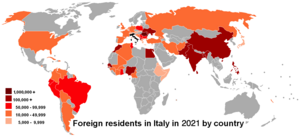
| Year | Population |
|---|---|
| 2002 | 1,341,209[84] |
| 2003 | 1,464,663[84] |
| 2004 | 1,854,748[84] |
| 2005 | 2,210,478[84] |
| 2006 | 2,419,483[84] |
| 2007 | 2,592,950[84] |
| 2008 | 3,023,317[84] |
| 2009 | 3,402,435[84] |
| 2010 | 3,648,128[84] |
| 2011 | 3,879,224[84] |
| 2012 | 4,052,081[85] |
| 2013 | 4,387,721[86] |
| 2014 | 4,922,085[87] |
| 2015 | 5,014,437[88] |
| 2016 | 5,026,153[89] |
| 2017 | 5,047,028[90] |
| 2018 | 5,144,440[91] |
| 2019 | 5,255,503[92] |
| 2020 | 5,013,215[93] |
| 2021 | 5,171,894 (8.7%)[94] |
There are, as of 2022, 5,030,716 Foreign-born residents, accounting for 8.5% of the total population.
Their distribution by country of origin was as follows:
| Country | Population[95] |
|---|---|
| 1,081,836 | |
| 416,829 | |
| 415,088 | |
| 307,038 | |
| 249,613 | |
| 174,058 | |
| 167,333 | |
| 158,926 | |
| 147,797 | |
| 144,129 | |
| 123,646 | |
| 112,598 | |
| 109,828 | |
| 109,804 | |
| 102,422 | |
| 98,733 | |
| 74,387 | |
| 63,211 | |
| 51,125 | |
| 51,090 | |
| 49,518 | |
| 47,335 | |
| 39,705 | |
| 36,372 | |
| 34,003 | |
| 30,835 | |
| 29,942 | |
| 29,571 | |
| 29,222 | |
| 28,559 | |
| 27,854 | |
| 27,758 | |
| 23,351 | |
| 22,693 | |
| 22,637 | |
| 21,032 | |
| 20,856 | |
| 20,454 |
Italy migration data
| Year | Emigration | Immigration | Net Migration |
|---|---|---|---|
| 1971 | 167,721 | 128,572 | -39,149 |
| 1972 | 141,852 | 138,246 | -3,606 |
| 1973 | 123,802 | 125,168 | 1,366 |
| 1974 | 112,020 | 116,708 | 4,688 |
| 1975 | 92,666 | 122,774 | 30,108 |
| 1976 | 97,247 | 115,997 | 18,750 |
| 1977 | 87,655 | 101,985 | 14,330 |
| 1978 | 85,550 | 89,897 | 4,347 |
| 1979 | 88,950 | 91,693 | 2,743 |
| 1980 | 84,877 | 90,463 | 5,586 |
| 1981 | 89,221 | 88,886 | -335 |
| 1982 | 98,241 | 92,423 | -5,818 |
| 1983 | 85,138 | 87,804 | 2,666 |
| 1984 | 77,318 | 77,002 | -316 |
| 1985 | 66,737 | 67,277 | 540 |
| 1986 | 57,862 | 56,006 | -1,856 |
| 1987 | 38,305 | 57,665 | 19,360 |
| 1988 | 36,660 | 52,562 | 15,902 |
| 1989 | 59,894 | 53,893 | -6,001 |
| 1990 | 48,916 | 70,035 | 21,119 |
| 1991 | 51,478 | 56,004 | 4,526 |
| 1992 | 50,226 | 54,849 | 4,623 |
| 1993 | 54,980 | 49,261 | -5,719 |
| 1994 | 59,402 | 46,761 | -12,641 |
| 1995 | 34,886 | 28,472 | -6,414 |
| 1996 | 39,017 | 28,816 | -10,201 |
| 1997 | 38,984 | 30,352 | -8,632 |
| 1998 | 38,148 | 29,946 | -8,202 |
| 1999 | 56,283 | 32,152 | -24,131 |
| 2000 | 47,480 | 34,411 | -13,069 |
| 2001 | 46,901 | 35,416 | -11,485 |
| 2002 | 34,056 | 44,476 | 10,420 |
| 2003 | 39,866 | 47,530 | 7,664 |
| 2004 | 39,155 | 41,794 | 2,639 |
| 2005 | 41,991 | 37,326 | -4,665 |
| 2006 | 46,308 | 37,666 | -8,642 |
| 2007 | 36,299 | 36,693 | 394 |
| 2008 | 39,536 | 32,118 | -7,418 |
| 2009 | 39,024 | 29,330 | -9,694 |
| 2010 | 39,545 | 28,192 | -11,353 |
| 2011 | 50,057 | 31,466 | -18,591 |
| 2012 | 67,998 | 29,467 | -38,531 |
| 2013 | 82,095 | 28,433 | -53,662 |
| 2014 | 88,859 | 29,271 | -59,588 |
| Year | Immigration | Emigration | Net Migration |
|---|---|---|---|
| 2002 | 316,278 | 51,494 | 264,784 |
| 2003 | 356,452 | 54,512 | 301,940 |
| 2004 | 358,415 | 59,885 | 298,530 |
| 2005 | 413,531 | 56,688 | 356,843 |
| 2006 | 466,718 | 60,471 | 406,247 |
| 2007 | 527,070 | 66,125 | 460,945 |
| 2008 | 535,349 | 80,894 | 454,455 |
| 2009 | 459,483 | 82,884 | 376,599 |
| 2010 | 458,856 | 92,585 | 366,271 |
| 2011 | 386,638 | 79,894 | 306,744 |
| 2012 | 321,324 | 106,177 | 215,147 |
| 2013 | 307,454 | 114,000 | 193,454 |
| 2014 | 277,631 | 136,328 | 141,303 |
| 2015 | 280,078 | 147,649 | 132,429 |
| 2016 | 300,823 | 157,627 | 143,196 |
| 2017 | 343,440 | 155,135 | 188,305 |
| 2018 | 332,324 | 157,417 | 174,907 |
| 2019 | 307,382 | 161,075 | 146,307 |
| 2020 | 248,070 | 160,579 | 87,491 |
| 2021 | 247,516 | 137,458 | 110,058 |
| 2022 | 345,716 | 141,028 | 204,688 |
| 2023 | 362,649 | 146,231 | 216,418 |
Languages
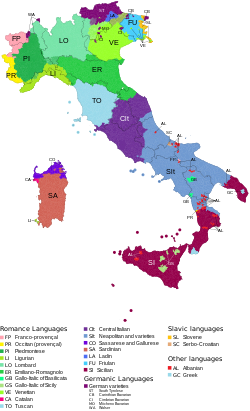
Italy's official language is Italian; Ethnologue has estimated that there are about 55 million speakers of Italian in the country and a further 6.7 million outside of it, primarily in the neighboring countries and in the Italian diaspora worldwide.[97] Italian, adopted by the central state after the unification of Italy, is a language based on the Florentine variety of Tuscan and is somewhat intermediate between the Italo-Dalmatian languages and the Gallo-Romance languages. Its development was also influenced by the Germanic languages of the post-Roman invaders. When Italy unified in 1861, only 3% of the population spoke Italian,[98] even though an estimated 90% of Italians speak Italian as their L1 nowadays.[99]
Italy is in fact one of the most linguistically diverse countries in Europe,[100] as there are not only varieties of Italian specific to each cultural region, but also distinct regional and minority languages. The establishment of the national education system has led to the emergence of the former and a decrease in the use of the latter. The spread of Italian was further expanded in the 1950s and 1960s, because of the economic growth and the rise of mass media and television, with the state broadcaster (RAI) setting a colloquial variety of Italian to which the population would be exposed.
As a way to distance itself from the Italianization policies promoted because of nationalism, Italy recognized twelve languages as the Country's "historical linguistic minorities",[101] which are promoted alongside Italian in their respective territories. French is co-official in the Aosta Valley as the province's prestige variety, under which the more commonly spoken Franco-Provencal dialects have been historically roofed.[102] German has the same status in the province of South Tyrol as, in some parts of that province and in parts of the neighbouring Trentino, does Ladin.[103] Slovene[104] and Friulian are officially recognised in the provinces of Trieste, Gorizia and Udine in Venezia Giulia. In Sardinia, the Sardinian language has been the language traditionally spoken and is often regarded by linguists as constituting its own branch of Romance;[105] in the 1990s, Sardinian has been recognized as "having equal dignity" with Italian,[106] the introduction of which to the island officially started under the rule of the House of Savoy in the 18th century.
In these regions, official documents are either bilingual (trilingual in Ladin communities) in the co-official language(s) by default, or available as such upon request. Traffic signs are also multilingual, except in the Valle d'Aosta where French toponyms are generally used, with the exception of Aosta itself, which has retained its Latin form in Italian as well as English. Attempts to Italianize them, especially during the Fascist period, have been formally abandoned. Education is possible in minority languages where such schools are operating.
UNESCO and other authorities recognize a number of other languages which are not legally protected by Italian government: Piedmontese, Venetian, Ligurian, Lombard, Emilian-Romagnolo, Neapolitan and Sicilian.
Religion
Religion in Italy according to the Eurobarometer survey, 2021[107]
Roman Catholicism is by far the largest religion in the country, although the Catholic Church is no longer officially the state religion. In 2006, 87.8% of Italy's population self-identified as Roman Catholic,[108] although only about one-third of these described themselves as active members (36.8%). In 2016, 71.1% of Italian citizens self-identified as Roman Catholic.[109] This increased again to 78% in 2018.[8]
Most Italians believe in God, or a form of a spiritual life force. According to a Eurobarometer Poll in 2005:[110] 74% of Italian citizens responded that 'they believe there is a God', 16% answered that 'they believe there is some sort of spirit or life force' and 6% answered that 'they do not believe there is any sort of spirit, God, or life force'. There are no data collected through census.
Christianity
The Italian Catholic Church is part of the global Roman Catholic Church, under the leadership of the Pope, curia in Rome, and the Conference of Italian Bishops. In addition to Italy, two other sovereign nations are included in Italian-based dioceses, San Marino and Vatican City. There are 225 dioceses in the Italian Catholic Church, see further in this article and in the article List of the Roman Catholic dioceses in Italy. Even though by law Vatican City is not part of Italy, it is in Rome, and along with Latin, Italian is the most spoken and second language of the Roman Curia.[111]
Italy has a rich Catholic culture, especially as numerous Catholic saints, martyrs and popes were Italian themselves. Roman Catholic art in Italy especially flourished during the Middle Ages, Renaissance and Baroque periods, with numerous Italian artists, such as Michelangelo, Leonardo da Vinci, Raphael, Caravaggio, Fra Angelico, Gian Lorenzo Bernini, Sandro Botticelli, Tintoretto, Titian and Giotto. Roman Catholic architecture in Italy is equally as rich and impressive, with churches, basilicas and cathedrals such as St Peter's Basilica, Florence Cathedral and St Mark's Basilica. Roman Catholicism is the largest religion and denomination in Italy, with around 71.1% of Italians considering themselves Catholic. Italy is also home to the greatest number of cardinals in the world,[112] and is the country with the greatest number of Roman Catholic churches per capita.[113]

Even though the main Christian denomination in Italy is Roman Catholicism, there are some minorities of Protestant, Waldensian, Eastern Orthodox and other Christian churches.
Immigration from Western, Central, and Eastern Africa at the beginning of the 21st century has increased the size of Baptist, Anglican, Pentecostal and Evangelical communities in Italy, while immigration from Eastern Europe has produced large Eastern Orthodox communities.
In 2006, Protestants made up 2.1% of Italy's population, and members of Eastern Orthodox churches comprised 1.2% or more than 700,000 Eastern Orthodox Christians including 180,000 Greek Orthodox,[116] 550,000 Pentecostals and Evangelists (0.8%), of whom 400,000 are members of the Assemblies of God, about 250,000 are Jehovah's Witnesses (0.4%),[117] 30,000 Waldensians,[118] 25,000 Seventh-day Adventists, 22,000 Mormons, 15,000 Baptists (plus some 5,000 Free Baptists), 7,000 Lutherans, 4,000 Methodists (affiliated with the Waldensian Church).[119]
Other religions
The longest-established religious faith in Italy is Judaism, Jews having been present in Ancient Rome before the birth of Christ. Italy has seen many influential Italian-Jews, such as prime minister Luigi Luzzatti, who took office in 1910, Ernesto Nathan served as mayor of Rome from 1907 to 1913 and Shabbethai Donnolo (died 982). During the Holocaust, Italy took in many Jewish refugees from Nazi Germany. However, with the creation of the Nazi-backed puppet Italian Social Republic, about 15% of 48,000 Italian Jews were killed. This, together with the emigration that preceded and followed the Second World War, has left only a small community of around 45,000 Jews in Italy today.
Due to immigration from around the world, there has been an increase in non-Christian religions. As of 2009, there were 1.0 million Muslims in Italy[120] forming 1.6 percent of population; independent estimates put the Islamic population in Italy anywhere from 0.8 million[121] to 1.5 million.[122] 50,000 Italian Muslims hold Italian citizenship.
There are more than 200,000 followers of faiths originating in the Indian subcontinent, including some 70,000 Sikhs with 22 gurdwaras across the country,[123] 70,000 Hindus, and 50,000 Buddhists.[124] There were an estimated 4,900 Bahá'ís in Italy in 2005.[125]
Education
Literacy
- definition: age 15 and over can read and write
- total population: 99.2%
- male: 99.4%
- female: 99% (2018 est.)
School life expectancy (primary to tertiary education)
- total: 16 years
- male: 16 years
- female: 17 years (2018)
Genetics and ethnic groups
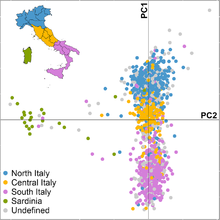
The genetic history of Italy is greatly influenced by geography and history. The ancestors of Italians are mostly Indo-European speakers (Italic peoples such as Latins, Umbrians, Samnites, Oscans, Sicels and Adriatic Veneti, as well as Celts, Iapygians and Greeks) and pre-Indo-European speakers (Etruscans, Ligures, Rhaetians and Camunni in mainland Italy, Sicani and Elymians in Sicily and the Nuragic people in Sardinia). During the imperial period of Ancient Rome, the city of Rome was also home to people from various regions throughout the Mediterranean basin, including Southern Europe, North Africa and the Middle East.[127] Based on DNA analysis, there is evidence of ancient regional genetic substructure and continuity within modern Italy dating to the pre-Roman and Roman periods.[128][129][130][131]
Within the Italian population, there is enough cultural, linguistic, genetic and historical diversity for them to constitute several distinct groups throughout the peninsula.[132] In this regard, peoples like the Friulians, the Ladins, the Sardinians and the South Tyroleans, who also happen to constitute recognized linguistic minorities, or even the Sicilians who are not, are cases in point, attesting to such internal diversity.
Linguistic minorities in Italy include Sardu-speakers 1 million, Tyrolese German-speakers 350,000, Albanians 70,000 – 100,000, Slovenes 60,000, Franco-Provençal-speakers 50,000 – 70,000, Occitans 20,000 – 40,000, Ladins 30,000, Catalans 15,000, Greek-speakers 12,000, Croatians 3,000 and Friulians 600,000. The Roma community is one of the largest ethnic minorities in Italy. Due to the lack of disaggregated data the size of the Italian Roma community remains unknown. The Council of Europe estimates that between 120,000 and 180,000 Roma live in Italy. A significant proportion of Roma in Italy do not have Italian citizenship.[133]
See also
- List of Italians
- Italian diaspora
- Italian Americans
- Italian Brazilians
- Italian Argentines
- Italian Venezuelans
- Romani people in Italy
Footnotes
- ^ In fertility rates, 2.1 and above is a stable population and has been marked blue, 2 and below leads to an aging population and the result is that the population decreases.
- ^ The figures for 2002–2011 have been revised downwards as a result of the 15th General Census of Italy which offered more precise data. The figures since 2012 are calculated adding to the foreign population enumerated by the census the foreign population inflows and outflows recorded in all Italian municipalities during each calendar year.
References
- ^ "Istat: Bilancio demografico Mensile".
- ^ "La mortalità in Italia sotto i 5 anni: aggiornamento dei dati per causa, territorio e cittadinanza". Istat.it. Istat. 18 October 2018. Retrieved 15 May 2021.
- ^ "Tendenze demografiche" (PDF). istat.it (in Italian). Retrieved 11 November 2023.
- ^ EUROSTAT. "Ageing characterises the demographic perspectives of the European societies – Issue number 72/2008" (PDF). Archived from the original (PDF) on 2 January 2009. Retrieved 28 April 2009.
- ^ ISTAT. "Crude birth rates, mortality rates and marriage rates 2005–2008" (PDF) (in Italian). Archived from the original (PDF) on 10 August 2011. Retrieved 10 May 2009.
- ^ ISTAT. "Average number of children born per woman 2005–2008" (PDF) (in Italian). Archived from the original (PDF) on 10 August 2011. Retrieved 3 May 2009.
- ^ "Births in Italy heading for new record low in 2023 - stats office". reuters. Retrieved 3 January 2024.
- ^ a b "Being Christian in Western Europe" (PDF). Pew Research Center. 2018. p. 22. Archived from the original (PDF) on 2 August 2019. Retrieved 5 January 2020.
- ^ "Causes of the Italian mass emigration". ThinkQuest Library. 15 August 1999. Archived from the original on 10 October 2010. Retrieved 30 October 2010.
- ^ "Dati dell'ambasciata italiana in Brasile" (in Italian). Archived from the original on 15 July 2015. Retrieved 10 February 2018.
- ^ "Italiani in Brasile" (in Italian). Archived from the original on 3 February 2009. Retrieved 10 February 2018.
- ^ Departamento de Derecho y Ciencias Políticas de la Universidad Nacional de La Matanza (14 November 2011). "Historias de inmigrantes italianos en Argentina" (in Spanish). infouniversidades.siu.edu.ar. Archived from the original on 15 July 2015.
Se estima que en la actualidad, el 90% de la población argentina tiene alguna ascendencia europea y que al menos 25 millones están relacionados con algún inmigrante de Italia.
- ^ "Welcome to the most Italian place in the United States. It's in New Jersey". Retrieved 18 April 2023.
- ^ "The Cambridge survey of world migration". Robin Cohen (1995). Cambridge University Press. p. 143. ISBN 0-521-44405-5
- ^ ""Noi veneti del Venezuela, siamo i nuovi profughi fantasma"". www.ilgazzettino.it (in Italian). 3 February 2020. Retrieved 14 November 2021.
- ^ "Los italianos y su aporte a la nación - Articulos - ABC Color".
- ^ "Ya se puede sacar la nacionalidad italiana" (in Spanish). Retrieved 29 May 2020.
- ^ "Destacan influencia de migración italiana en la sociedad paraguaya" (in Spanish). 7 September 2017. Retrieved 18 June 2020.
- ^ "Convenzioni Inps estere, Fedi sollecita Nuova Zelanda ma anche Cile e Filippine" (in Italian). Archived from the original on 9 February 2018. Retrieved 10 February 2018.
- ^ "- Uruguay - Info". www.hotelsclick.com.
- ^ Giner Vásquez, Renzo (27 September 2017). "Embajador de Italia en Perú: Acá hay muchas oportunidades para nuestras empresas". El Comercio. Retrieved 22 December 2019.
- ^ Government of Canada, Statistics Canada (26 October 2022). "Ethnic or cultural origin by generation status: Canada, provinces and territories, census metropolitan areas and census agglomerations with parts". www12.statcan.gc.ca. Retrieved 26 October 2022.
- ^ Recchi, Ettore; Baglioni, Lorenzo Gabrielli e Lorenzo G. (16 April 2021). "Italiani d'Europa: Quanti sono, dove sono? Una nuova stima sulla base dei profili di Facebook". Neodemos (in Italian). Retrieved 31 January 2022.
- ^ "ABS Ancestry". 2012.
- ^ "Essay on Italian emigration to Eritrea (in Italian)" (PDF). Retrieved 30 October 2010.
- ^ Libya – Italian colonization. Britannica Online Encyclopedia.
- ^ Thammy Evans & Rudolf Abraham (2013). Istria. Bradt Travel Guides. p. 11. ISBN 9781841624457.
- ^ James M. Markham (6 June 1987). "Election Opens Old Wounds in Trieste". The New York Times. Retrieved 9 June 2016.
- ^ Libya cuts ties to mark Italy era.. BBC News. 27 October 2005.
- ^ Bonifazi, Corrado; Heins, Frank; Strozza, Salvatore; Vitiello, Mattia. "Italy: The Italian transition from an emigration to immigration country". ResearchGate.net. Idea Working Papers. Retrieved 17 May 2021.
- ^ "La popolazione straniera residente in Italia nel 2014" (in Italian). National Institute of Statistics (Italy). 12 February 2015. Retrieved 24 April 2015.
- ^ Caponio, Tiziana; Cappiali, Teresa. "Italian Migration Policies in Times of Crisis: The Policy Gap Reconsidered" (PDF). European University Institute. Retrieved 17 May 2021.
- ^ a b c "Indicatori demografici, anno 2020" (PDF). Retrieved 3 May 2021.
- ^ S.A, Telewizja Polska. "Italian population keeps shrinking as birth rate hits record low in 2022". tvpworld.com. Archived from the original on 24 April 2023. Retrieved 10 May 2023.
- ^ "Italian births drop to lowest level since country's unification". Financial Times. 7 April 2023. Retrieved 10 May 2023.
- ^ "Population collapse imminent? Italy's birth rate drops to historic low in 2022". WION. 8 April 2023. Retrieved 10 May 2023.
- ^ April 08; 2023 - 5:27pm (8 April 2023), Italy's national birth rate declared a national emergency, retrieved 10 May 2023
{{citation}}: CS1 maint: numeric names: authors list (link) - ^ "Italy's Birth Rate Slumps to a Historical Low, Istat Says". Bloomberg.com. 7 April 2023. Retrieved 10 May 2023.
- ^ "Births in Italy hit record low in 2022, population shrinks further". Reuters. 7 April 2023. Retrieved 10 May 2023.
- ^ "L'Italia in 150 anni. Sommario di statistiche storiche 1861–2010" (PDF). Istat. Retrieved 17 May 2021.
- ^ "15o Censimento generale della popolazione e delle abitazioni" (PDF). Istat. Retrieved 17 May 2021.
- ^ a b "Indicatori demografici" [Demographic indicators]. Italian National Institute of Statistics (in Italian). Retrieved 14 February 2024.
- ^ a b c d e f g h "Life expectancy". Our World in Data. Retrieved 28 August 2018.
- ^ "World Population Prospects – Population Division – United Nations". Archived from the original on 19 September 2016. Retrieved 15 July 2017.
- ^ a b "Italia, crollo natalità – In dieci anni i nuovi nati scendono del 25%. Ecco i motivi". torinonews24.it. 21 February 2023.
- ^ a b c Max Roser (2014), "Total Fertility Rate around the world over the last centuries", Our World in Data, Gapminder Foundation, archived from the original on 7 August 2018, retrieved 7 August 2018
- ^ "L'emigrazione interna italiana negli anni '50 e '60" (in Italian). 16 November 2012. Retrieved 8 February 2018.
- ^ "Una indagine CATI per lo studio della mobilità interna in Italia in un'ottica longitudinale" (PDF) (in Italian). Archived from the original (PDF) on 20 April 2021. Retrieved 8 February 2018.
- ^ "Lombardo". treccani.it (in Italian). Retrieved 15 April 2022.
- ^ Graham A. Loud; Alex Metcalfe (2002). The Society of Norman Italy. BRILL. ISBN 9004125418.
- ^ These Lombard colonisers were native northern Italians and should not be confused with the Germanic tribe the Lombards, who were referred to as longobardi to distinguish them from the Italians of the region who were known as lombardi.
- ^ Fiorenzo Toso (2008). Le minoranze linguistiche in Italia (in Italian). Il Mulino. p. 137. ISBN 978-88-15-12677-1.
- ^ "The World Factbook – Central Intelligence Agency". cia.gov. Archived from the original on 22 January 2019. Retrieved 19 December 2011.
- ^ OECD. "Competitive Cities in the Global Economy" (PDF). Archived from the original (PDF) on 1 October 2008. Retrieved 30 April 2009.
- ^ Roberto, Vincenzo Patruno, Marina Venturi, Silvestro. "Demo-Geodemo. – Mappe, Popolazione, Statistiche Demografiche dell'ISTAT". demo.istat.it. Archived from the original on 9 July 2011.
{{cite web}}: CS1 maint: multiple names: authors list (link) - ^ "Population on 1 January by age groups and sex – functional urban areas". Eurostat. Archived from the original on 3 September 2015. Retrieved 3 November 2017.
- ^ B. R. Mitchell. European historical statistics, 1750–1975.
- ^ "United nations. Demographic Yearbook 1952" (PDF).
- ^ Roberto, Vincenzo Patruno, Marina Venturi, Silvestro. "Demo-Geodemo. – Mappe, Popolazione, Statistiche Demografiche dell'ISTAT". demo.istat.it.
{{cite web}}: CS1 maint: multiple names: authors list (link) - ^ Arachi, Alessandra (15 December 2022). "Siamo sempre meno e sempre più anziani, calano gli stranieri". Corriere della Sera. Retrieved 15 December 2022.
- ^ "Population on 1 January by age and sex". ec.europa.eu. Retrieved 7 December 2023.
- ^ a b "Monthly Demographic Balance". demo.istat.it.
- ^ https://ec.europa.eu/eurostat/databrowser/view/demo_gind/default/table?lang=en&category=demo.demo_ind [bare URL]
- ^ "The World FactBook – Italy", The World Factbook, 3 February 2021
- ^ Resident population at 1 January and average by region and geographical area - Years 1952-2014, visited August 27 2023
- ^ "Birthrate and fertility".
- ^ https://unstats.un.org/unsd/demographic-social/products/dyb/#statistics> [bare URL]
- ^ "Emigration and Its Economic Impact on Eastern Europe" (PDF). International Monetary Fund. Retrieved 17 May 2021.
- ^ "Migration from the Middle East and North Africa to Europe" (PDF). Amsterdam University Press. Retrieved 17 May 2021.
- ^ "Chinese immigration into the Eu: new trends, dynamics and implications" (PDF). The Europe China Research and Advice Network (ECRAN). Retrieved 17 May 2021.
- ^ Shendruk, Amanda (8 July 2021). "Are you even trying to stop racism if you don't collect data on race?". Quartz. Retrieved 4 July 2022.
- ^ "Acquisitions of citizenship : Most relevant country of citizenship". 2021. Retrieved 29 November 2022.
- ^ Elisabeth Rosenthal, "Italy cracks down on illegal immigration". The Boston Globe. 16 May 2008.
- ^ "EUROPE: Home to Roma, And No Place for Them". IPS ipsnews.net. Archived 5 March 2012 at the Wayback Machine
- ^ "Cittadini stranieri. Popolazione residente e bilancio demografico". istat.it (in Italian). istat. 31 December 2018. Retrieved 24 January 2019.
- ^ Lanni, Alessandro (27 December 2015). "From Morocco to Romania: how immigration to Italy has changed over 10 years". Open Migration. Retrieved 10 March 2016.
- ^ "Società Stranieri in Italia, 5,2 milioni i residenti regolari. Romania e Cina le provenienze con i maggiori incrementi negli ultimi 8 anni". Il Fatto Quotidiano. 20 September 2019. Retrieved 15 May 2021.
- ^ Chang, Angela (24 February 2012). "20th Century Chinese Migration to Italy: The Chinese Diaspora Presence within European International Migration". ResearchGate. Retrieved 11 March 2015.
- ^ "I numeri degli stranieri residenti in Italia". Youtrend.it. 9 December 2020. Retrieved 15 May 2021.
- ^ a b c d "Estimated resident population – Years 2002–2019". dati.istat.it. Retrieved 22 December 2021.
- ^ "Resident foreigners on 1st January – Citizenship : Italy, regions, provinces – Area of citizenship". dati.istat.it.
- ^ "Resident foreigners on 1st January – Citizenship : Italy, regions, provinces – Area of citizenship". dati.istat.it. Archived from the original on 28 January 2022.
- ^ "Resident foreigners on 1st January - Citizenship".
- ^ a b c d e f g h i j "Ricostruzione della popolazione residente per età, sesso e cittadinanza nei comuni". ISTAT. 26 September 2013. p. 9.
- ^ Statistics for 2011 at istat.it Accessed 30 October 2017.
- ^ Statistics for 2013 at istat.it Archived 31 March 2017 at the Wayback Machine Accessed 30 October 2017.
- ^ Statistics for 2013 at istat.it Archived 30 July 2015 at the Wayback Machine Accessed 30 October 2017.
- ^ "Cittadini Stranieri. Popolazione residente e bilancio demografico al 31 dicembre 2014". ISTAT. 15 June 2015. Archived from the original on 26 October 2019. Retrieved 19 May 2021.
- ^ Statistics for 2015 at istat.it Archived 13 June 2016 at the Wayback Machine Accessed 30 October 2017.
- ^ Statistics for 2017 at istat.it Archived 7 July 2017 at the Wayback Machine Accessed 4 April 2018.
- ^ "Statistiche demografiche ISTAT". Archived from the original on 6 August 2017. Retrieved 18 April 2019.
- ^ "5.255.503 cittadini stranieri in Italia". aise.it (in Italian). 24 October 2019. Retrieved 15 March 2020.
- ^ "Bilancio demografico popolazione straniera". demo.istat.it.
- ^ "Population by citizenship".
- ^ "Resident foreigners on 1st January - Citizenship". dati.istat.it. Retrieved 4 November 2022.
- ^ "International Migration". Istat. Retrieved 31 May 2024.
- ^ Ethnologue report for language code:ita (Italy) – Gordon, Raymond G., Jr. (ed.), 2005. Ethnologue: Languages of the World, Fifteenth edition. Dallas, Tex.: SIL International. Online version
- ^ "Italian | Ethnologue Free". Ethnologue (Free All).
- ^ "L'uso della lingua italiana, dei dialetti e di altre lingue in Italia". Istat. 9 March 2018.
- ^ «Italy holds especial treasures for linguists. There is probably no other area of Europe in which such a profusion of linguistic variation is concentrated into so small a geographical area». Martin Maiden, M. Mair Parry (1997), The Dialects of Italy, Psychology Press, p. 1
- ^ Norme in materia di tutela delle minoranze linguistiche storiche, Italian parliament, retrieved 17 October 2015
- ^ L.cost. 26 febbraio 1948, n. 4, Statuto speciale per la Valle d'Aosta
- ^ L.cost. 26 febbraio 1948, n. 5, Statuto speciale per il Trentino-Alto Adige
- ^ L.cost. 31 gennaio 1963, n. 1, Statuto speciale della Regione Friuli-Venezia Giulia
- ^ Martin Maiden, M. Mair Parry (1997), The Dialects of Italy, Psychology Press, p. 2
- ^ "Legge Regionale 15 ottobre 1997, n. 26-Regione Autonoma della Sardegna". Archived from the original on 1 March 2021. Retrieved 19 November 2019.
- ^ "Special Eurobarometer 516". European Union: European Commission. September 2021. Retrieved 24 September 2021 – via European Data Portal (see Volume C: Country/socio-demographics: IT: Question D90.2.).
- ^ "Italy: 88% of Italy's population declare themselves Catholic" (in Italian). Corriere della Sera. 18 January 2006. Retrieved 10 May 2009.
- ^ "Rapporto Italia 2016. La sindrome del Palio" (in Italian). 28 January 2016. Retrieved 10 November 2018.
- ^ "ReportDGResearchSocialValuesEN2.PDF" (PDF). Archived from the original (PDF) on 24 May 2006.
- ^ "Country profile: Vatican". BBC News. 26 October 2009. Retrieved 5 May 2010.
- ^ Miranda, Salvador. "Living cardinals arranged by country". The Cardinals of the Holy Roman Church. Florida International University. OCLC 53276621.
- ^ "Italy – Italian Language, Culture, Customs and Business Etiquette". Kwintessential.co.uk. Archived from the original on 12 August 2010. Retrieved 2 August 2010.
- ^ "The Duomo of Florence | Tripleman". tripleman.com. Archived from the original on 6 December 2009. Retrieved 25 March 2010.
- ^ "brunelleschi's dome – Brunelleschi's Dome". Brunelleschisdome.com. Retrieved 25 March 2010.
- ^ The Holy Orthodox Archdiocese of Italy and Malta Archived 5 March 2009 at the Wayback Machine
- ^ 2015 Yearbook of Jehovah's Witnesses. Watch Tower Society. p. 182.
- ^ "Waldensian Evangelical Church". Archived from the original on 11 February 2006.
- ^ "World Council of Churches". Archived from the original on 25 March 2013.
- ^ "Italy: Country's muslims raise funds to help quake victims – Adnkronos Religion". adnkronos.com.
- ^ "Muslims in Europe: Country guide". BBC News. 23 December 2005. Retrieved 5 May 2010.
- ^ Rosenthal, Elisabeth (25 July 2005). "Pressure is growingon Muslims in Italy". The New York Times. Retrieved 31 March 2010.
- ^ "NRI Sikhs in Italy". nriinternet.com.
- ^ "Unione Buddhista Italiana – UBI: L'Ente". www.buddhismo.it. Archived from the original on 4 April 2007.
- ^ "Most Baha'i Nations (2005)". QuickLists > Compare Nations > Religions >. The Association of Religion Data Archives. 2005. Archived from the original on 14 April 2010. Retrieved 30 January 2010.
- ^ Parolo, Silvia; Lisa, Antonella; Gentilini, Davide; Di Blasio, Anna Maria; Barlera, Simona; Nicolis, Enrico B.; Boncoraglio, Giorgio B.; Parati, Eugenio A.; Bione, Silvia (2015). "Characterization of the biological processes shaping the genetic structure of the Italian population". BMC Genetics. 16: 132. doi:10.1186/s12863-015-0293-x (inactive 5 December 2024). PMC 4640365. PMID 26553317. S2CID 17969623.
{{cite journal}}: CS1 maint: DOI inactive as of December 2024 (link) - ^ Antonio ML, Gao Z, Moots HM, Lucci M, Candilio F, Sawyer S, et al. (November 2019). "Ancient Rome: A genetic crossroads of Europe and the Mediterranean". Science. 366 (6466). American Association for the Advancement of Science (published 8 November 2019): 708–714. Bibcode:2019Sci...366..708A. doi:10.1126/science.aay6826. hdl:2318/1715466. PMC 7093155. PMID 31699931.
Interestingly, although Iron Age individuals were sampled from both Etruscan (n=3) and Latin (n=6) contexts, we did not detect any significant differences between the two groups with f4 statistics in the form of f4(RMPR_Etruscan, RMPR_Latin; test population, Onge), suggesting shared origins or extensive genetic exchange between them. ... In the Medieval and early modern periods (n = 28 individuals), we observe an ancestry shift toward central and northern Europe in PCA (Fig. 3E), as well as a further increase in the European cluster (C7) and loss of the Near Eastern and eastern Mediterranean clusters (C4 and C5) in ChromoPainter (Fig. 4C). The Medieval population is roughly centered on modern-day central Italians (Fig. 3F). It can be modeled as a two-way combination of Rome's Late Antique population and a European donor population, with potential sources including many ancient and modern populations in central and northern Europe: Lombards from Hungary, Saxons from England, and Vikings from Sweden, among others (table S26).
- ^ Ralph P, Coop G (2013). "The geography of recent genetic ancestry across Europe". PLOS Biology. 11 (5): e1001555. doi:10.1371/journal.pbio.1001555. PMC 3646727. PMID 23667324.
- ^ Raveane A, Aneli S, Montinaro F, Athanasiadis G, Barlera S, Birolo G, et al. (September 2019). "Population structure of modern-day Italians reveals patterns of ancient and archaic ancestries in Southern Europe". Science Advances. 5 (9): eaaw3492. Bibcode:2019SciA....5.3492R. doi:10.1126/sciadv.aaw3492. PMC 6726452. PMID 31517044.
- ^ Capocasa M, Anagnostou P, Bachis V, Battaggia C, Bertoncini S, Biondi G, et al. (2014). "Linguistic, geographic and genetic isolation: a collaborative study of Italian populations". Journal of Anthropological Sciences. 92 (92): 201–31. doi:10.4436/JASS.92001. PMID 24607994.
- ^ Modi A, Lancioni H, Cardinali I, Capodiferro MR, Rambaldi Migliore N, Hussein A, et al. (July 2020). "The mitogenome portrait of Umbria in Central Italy as depicted by contemporary inhabitants and pre-Roman remains". Scientific Reports. 10 (1): 10700. Bibcode:2020NatSR..1010700M. doi:10.1038/s41598-020-67445-0. PMC 7329865. PMID 32612271.
- ^ «Italians, though often described as a homogeneous people, are divided into several culturally, socially, and politically diverse groups throughout the peninsula.» Jeffrey Cole (edited by), Ethnic Groups of Europe: An Encyclopedia, Santa Barbara (California), ABC-CLIO, 2011, p.204
- ^ "Italy - World Directory of Minorities & Indigenous Peoples". 2 November 2023.
External links
- Demographic page Archived 22 June 2017 at the Wayback Machine
- Demographic Profile Italy Allianz Knowledge
